Santiago! The Christianizing of Iberia - New Use for a Dead Jew
The Saint at the End of the World
One might be a tad surprised that an ancient Jew is the patron saint of (at least until recently) a fiercely Catholic country, one with a notable history of anti-semitism. But then again, papal Rome had staked its claim to world mastery on the fabricated legend of another Jew, ‘Peter, Prince of the Apostles.’ And the emerging French kingdom would enter the fray with a claim to Mary Magdalene, her brother Lazarus (St Lazare) and sister Martha (‘cast up on the shores of Provence’). Christian Spain grew from a barbarous kingdom clinging to the mountains of the northwest, a long way from the Palestinian pageant – but even this was not too big a challenge for the creative fraudsters of the Church.
Who could seriously doubt that a dead 1st century Jew from Galilee was inextricably linked to a remote hamlet in medieval Spain?
Way to Go, James! (100% Credulity Required)
Several hundred years after his supposed life came to its supposed end, James the Greater, Apostle of the Lord, son of Zebedee and brother of John, embarked on an altogether far more illustrious career than catching fish and traipsing after a wandering carpenter in Judaea.
Although for 800 years no one had noticed, it seems that in the interlude between the godman’s crucifixion and his own beheading by Herod Agrippa, apostle James had evangelised on the western fringe of the Roman world in northwest Spain!
The Christian bishops of Roman Baetica (southern Spain) knew nothing of it. Visigothic Christians, Arian and Catholic alike, had no inkling. Isidore of Seville, the erudite 7th century Doctor of the Church whose encyclopedic ‘Etymologies’ was an attempt to catalogue all known knowledge (and included a history of Spain, martyrs and the Church!) is silent on ‘James.’
Remarkably, only in the 8th century, did the ‘news’ emerge that the ‘son of thunder’ had spread the word in Hispania. Indeed at one point James had found himself on the banks of the Ebro when an apparition of the Virgin Mary had appeared, directing him to build a church – possibly the only instance of the Virgin making a phantom appearance whilst still alive (and apparently living with brother John in Ephesus!)

Apostle James – simple fisherman fluent in Aramaic and Spanish mountain dialects!
James, of course, had an appointment with martyrdom to keep (Acts 12.2) and scuttled back to the Holy Land. Thanks to startling revelations first revealed in the 13th century, his career was only just beginning. His body and severed head, left for the dogs to eat, were rescued by adoring fans and carried aboard a rudderless stone boat found in the port of Jaffa.
At sea for seven days, a divine wind blew the mariners clean across the Mediterranean, through the Straits of Gibraltar and all the way up the west coast of Spain to make landfall close by the Roman settlement of Iria Flavia in the north (in a region called by the Romans ‘Finis Terrae’, ‘end of the world’).
Carrying the body ashore, the enthusiasts overcame the resistance of a local pagan queen with miracles. She of course converted on the spot and made available her ‘palace’ for final burial of the body. And that’s how things remained until centuries into the future (around the year 813) – the tomb long forgotten – a pious hermit Pelagius was guided by a light in the sky and the accompaniment of a celestial chorus to the very place. Digging and finding bones he called for the local bishop Teodomiro who, with remarkable forensic prescience, was immediately able to identify the bones as the relics of St James!
The devout king of Asturia, Alfonso ‘the Chaste’, endorsed the discovery by declaring James the patron saint of his fledgling kingdom. His son Ramiro I (842-850) reaped the benefit with a sword-wielding James fighting by his side! – bringing him victory over a vast army of infidel Moors at the battle of Clovijo (actually fought in 859!).
‘Santiago Matamoros’ (‘St James the Moor-slayer’) had arrived – and the rest is history!
The Roads to Santiago de Compostela
In the 11th century Christendom was gearing up for war with Islam. Pilgrimage had a vital part to play, heightening religious tension and encouraging enthusiasm for the approaching conflict.
While Jerusalem and Rome were considered the two most important pilgrimage destinations, Santiago de Compostela in the Iberian peninsula was closer and much safer to visit and received far more visitors. Even so, pilgrims usually travelled in convoys for safety.
Four major land routes to Santiago developed. Originating in northern France and meandering south through other pilgrimage sites (‘Mary Magdalene’ finished up at Vezeley, for example), the routes joined, crossed the Pyrenees and then went on to northwest Spain.

From desperate mountain redoubts the small, barbarous kingdoms of northern Spain eyed with envy the wealth of the caliphate. None possessed a town with more than a thousand people, compared to the 50,000 of Moorish Saragossa and several times that number in Cordoba.
To realize their dreams of conquest they required manpower and weaponry – and this the Franks could provide. The Franks had developed chain mail for their feudal knights and the heavy horse to carry the weight.
Santiago de Compostela proved the perfect magnet, drawing in thousands of pilgrims annually who then required protection from knightly orders of armed monks.
Pope Alexander III declared Santiago a ‘Holy City’ and war against the Moor a crusade which would reward the fallen with a ‘martyr’s crown.’
The knights established monasteries, hostels and castles (hence ‘Castile’, the frontier zone) and were rewarded with their own towns (Estelle, Villafranca del Bierzo, Villafranca de Montes de Oca, etc.) and estates in conquered territory.
Moors from the south, Franks from the north
Iberia in the 8th Century
The harsh Catholic regime imposed by the late Gothic warrior aristocracy survived little more than a century. So disaffected were most of the people that when the Arab/Berber armies appeared in the south at the beginning of the 8th century they were able to conquer almost the whole of Spain within five years.
The so-called ‘reconquest’ would take seven hundred years.
Many towns capitulated in return for the promise of religious tolerance. Those who had suffered most from the harsh Visigothic Catholic kings – Arians, gnostics, heretics, and Jews – welcomed and assisted the new rulers. Even some Visigothic princes (for example, Theodemir of Murcia) submitted to the Arab overlords and kept their thrones. Other Gothic warriors fled to the north, hiding in the mountains of the Asturias from where they could plead for assistance from the more triumphant Franks.
We know of one Gothic aristocrat, Pelayo (aka Pelagius – the name assigned to the monk of the Santiago legend!), a warrior who had fought with Roderic at the disastrous battle of Guadalete (711). He fled defeat in the far south to find safety in the far north. In 718 he declared himself ‘king of the Asturias’ – at the time a fairly meaningless claim. After several years of banditry in the mountains, and with the ‘Moors’ (so-named from the old Roman province of Mauritania) preoccupied with a major campaign against the Franks in southwest France, Pelayo was able to defeat local Berber forces in a minor skirmish, the so-called ‘Battle of Covadonga’ (722). He was thereafter able to consolidate a small mountain ‘kingdom of Asturia’ before his death in 737.
The small enclave owed its survival to discrimination and division within the Islamic forces. Berber foot soldiers earned only one third as much as Arab horsemen. When they were settled in the peninsula they tended to be allocated the mountain regions, while the lowland, much of it irrigated, was given to Arabs and worked by converts to Islam (‘Muwallads’) or Christian tenants. When a mid-century famine caused the impoverished Berber settlers to return to North Africa, Christian mountain tribes began to settle Galicia, where they were able to maintain a precarious, though barbarous, existence.
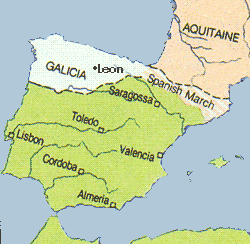
Al Andalus – ruled initially by a governor based in Kairouan (‘caravan’) in North Africa.
Iberian Peninsular – 8th century 712: Following the Arab conquest, the mountains of the northwest are thinly settled by Berber tribesmen. 740: Dissatisfied and influenced by North African Khârijism (the first puritanical and fundamentalist movement within Islam), Berbers in Galicia rebel. They are suppressed the following year by fresh Arab troops arriving from Syria. 748-753: A disastrous drought and famine induces the poverty-stricken Berbers of Galicia to return to their North African homeland. Christian ‘mountain men’ move into the abandoned region. The Douro Valley remains largely depopulated. 791-842: The ‘Kingdom of the Asturias’ under Alfonso II overruns a number of Muslim strongholds and settles the lands south of the river Douro. His new capital is the abandoned Roman legionary fortress of Leon. |
The French Connection
It was a more serious division within the Muslim ranks which allowed the Carolingian Franks entry into the peninsular. In 749/750 The ruling Umayyad dynasty of Damascus was murdered en masse by rival Abbasids, throwing the entire Islamic empire into turmoil. One Umayyad prince – Abed Al-Rahman I – fled to the distant province of al Andalus (Spain) where a fierce power struggle ensued.
By 756 Rahman was able to re-established Umayyad rule but his defeated Abbasid rivals appealed to the Franks. Pepin the Short seized the opportunity to take Arab possessions north of the Pyrenees and his warrior son Charlemagne (768-814) established a dependency of the ‘County of Barcelona’ south of the Pyrenees early in the 9th century. This was the largest of a number of Carolingian dependencies – Aragon, Sobarabe, Ribagorza – created in the so-called ‘Spanish March.’
Further west the mountainous Basque region – half in Spain and half in France – retained a tenacious independence, having defeated Charlemagne himself in 778. But Catholic agents moved through this half-Christian, half-pagan land and the Franks maintained an interest.
‘St James’ Takes a Spanish Holiday
The ‘Kingdom of the Asturias’ took advantage of temporary Muslim weakness in the 9th century to expand into a ‘Kingdom of Galicia’, moving its capital to Leon, the legionary fortress abandoned by the Romans centuries earlier. Its king was none other than Alfonso II (791-842) – who found it very convenient, when attempting to subdue the west of Galicia, to have a shrine about which to rally support.
Teodemir, bishop of the old Roman settlement of Iria Flavia, drew the warlord’s attention to a graveyard (‘compostela’ in Latin) to the north of his diocese which evidently already had a shrine of sorts. There is a suggestion it may have been a shrine of Priscillian, the murdered heretic, and the graves those of his followers!
Whatever the case, a ‘miraculous discovery’ had been made. Bishop Teodomir and Alfonso announced to the faithful the shrine of ‘Santiago de Compostela’ (now supposedly derived from ‘campus stellae’ – ‘field of stars’!– a name which supported their fanciful story). Over what was declared to be the ‘tomb of St James’ a church was constructed. The year was 829.
Guidance in the shrine creation business came from Frankish monks for whom the shrine of ‘Martin of Tours’ was doing brisk business in northern France. Essential was an ‘ambulatory’ around an effigy of the saint. With sufficient holy relics lepers could be cured and the dead raised. Cluniacs and Augustinians began to move into the Asturias, binding ever-tighter the Spanish church to Roman Catholicism.
By the reign of Alfonso III (899), the church of Santiago had grown into a large basilica and, thanks to a timely outbreak of Jamesian miracles, the shrine was drawing fans from across Iberia. Frankish kings were pleased to sponsor the new kingdom in the peninsular. The French bishop Godescalc of Le Puy visited Santiago in 950 and with his energetic promotion ‘Santiago de Compostela’ began to attract pilgrims from across Europe.
But by then Moorish Spain had entered its golden age.
Golden Al Andalus – 10th/ 11th Centuries
Once established Umayyad Spain took Moorish power to new heights. The small Christian kingdoms in the north, though never conquered, were forced into paying tribute to their Islamic neighbour. The lavish court life of Cordoba, Seville and Granada nurtured a ‘golden age’ of Islam in Spain lasting nearly 300 years. Cordoba was paved, lit and supplied with fresh water at a time when all other towns of Europe were dirty, dank and rank with disease.
In 929, in a challenge to the weakening Abbasids of Baghdad and rival Fatamids in north Africa, emir Abd al-Rahman III (912-961) proclaimed himself Caliph. During the reign of this urbane and skeptical monarch (who enjoyed the title al-Nasir – ‘Defender of the Faith’!) al Andalus reached its zenith.
Rahman stabilized the frontier with the Christian states (he sacked Pamplona, the capital of Navarre in 924 and quashed a rebellion at Toledo in 932) but otherwise traded quite happily with them outside the campaign season. He went on to build a fleet at Almeria with which he conquered key ports in North Africa (Melilla 927, Ceuta 931, Tángier 951). A Muslim base established at Fraxinetum (near St Tropez) in Provence enabled Arab raiders to strike far into Gaul (the settlement was ejected in 975).
More memorably, Rahman’s achievements included founding a university, a medical school, and an opulent new city of Madinat al-Zahra from which to administer his ’empire.’
Prosperity continued under the reign of Rahman’s son Hakem II al Mustansir (961-976), an enlightened prince who was drawn particularly to the arts and literature. Reputedly, he assembled a library of more than 400,000 volumes and founded 27 state schools. He relied rather too heavily on his chamberlain, vizier and generals to run the kingdom. When Hakem died leaving an infant son Hisham II (976-1009) – of a Basque mother – effective power was seized by former vizier Ibn Abi Amir (aka ‘Almanzor’).

Madinat al-Zahra, a 10th century palatial city on a hillside outside Córdoba. Not rediscovered until 1910, less than 10 of more than 100 hectares of the city have been excavated.
A warrior, not a scholar, al-Mansur (981-1002) strengthened his own position by an outward show of return to Islamic piety. Slav bodyguards were replaced with devout Berbers. The young caliph himself was confined to sensual pleasure, locked away in his Cordoban palace.
Mansur waged no fewer than 53 campaigns against the Christian kingdoms of the north. Santiago was sacked in 997 and the kingdom of Leon forced into submission, compelled to provide Leonese soldiers for the Moorish armies.
More than ever, the Arab elite relied on Berber troops – a weakness that (like imperial Rome’s dependence on German auxillaries) would be its eventual undoing. With central authority resting on a growing bureaucracy of slaves, freemen and mercenary soldiers – the resentment of provincial Arab aristocrats grew. With Mansur’s death, local governors proclaimed independent kingdoms (the so-called ‘taifas’ or petty monarchies), with Seville, Toledo, Valencia and Saragossa the most powerful.
Civil war (1008-1028) destroyed the unity and strength of Islamic Spain as these local chieftains turned to outside help – Christian and North African – to survive. The taifa states, each lacking the caliphate’s military muscle, at first paid the northern raiders to go away – just as imperial Rome had tried to buy off Goths and Huns six hundred years earlier. With the money, the Christians bought weapons and horses and renewed their attacks. Then the emirs turned to hiring Christian mercenaries – Catalans, Basques, Asturians – to fight for them (again, paralleling the policy of the feeble caesars). Most notable of the adventurers to fight both for and against the Moors was the Castilian knight Rodrigo Diaz de Bivar – better known by his Arab name ‘el Cid’ (from Spanish Arabic as-sid, ‘lord’). The Cid, like many a hired general, eventually became a ruler himself, at one point taking control of Valencia.
Christianity’s Holy Warriors Tussle for Supremacy

Fragmentation of 11th century al Andalus
The caliphate finally disappeared in 1031, a casualty of Berber/Arab civil wars. Navarre, most insulated from the conflicts of the peninsular, was best placed of the Christian kingdoms to take advantage of the debacle.
In the early years of the 11th century Sancho III of Navarre subdued the counties of the ‘Spanish March’ – Aragon, Sobrarbe and Ribagorza – and then carved ‘Castile’ out of Leon in 1026. But the unity of ‘greater Navarre’ ended with Sancho’s death in 1033 and division of his kingdom among his sons: Navarre to Garcia, Aragon, Sobrarbe and Ribagorza to Ramiro, and Castile to Fernando.
With Fernando’s own death in 1063 the union he had forged with the remnant of Leon dissolved (Castile going to Sancho II and Leon to Alfonso V) only to be re-made again under Alfonso VI. Meanwhile, the states of Aragon and Navarre were united in 1076 (only to separate again in 1134!). Alfonso, impatient of merely exacting tribute from the Islamic princes, struck south, taking Toledo from the Muslims in 1085. With a population of twenty eight thousand, it immediately became the largest city of his realm and a cornucopia of Arabic learning. A Cluniac monk, Bernard of Sedirac, was appointed archbishop for the city and the Mozarabic liturgy was replaced by the Roman.
Elsewhere, raiding parties of heavily mailed Christian cavalry, unable to take cities, instead wrecked caravans and noria waterwheels, destroyed livestock and mature grapevines.
Alarmed by the Christian attacks the Muslim kings of Granada, Seville and Badajoz appealled to the Almoravides of North Africa. It was a reluctant choice – the Almoravides were the Taliban of their day, veiled warriors ruled by a strict Sharia law. In 1086, the Almoravid leader, Yusuf ibn Tashufin, landed his army in al-Andalus and defeated the Christians near Badajoz. Rapidly Tashufin imposed his control over the Muslim-ruled cities – Granada, Almeria, Seville, Valencia, Saragossa and Lisbon. For half a century al-Andalus regained a unity, albeit for the first time experiencing Muslim intolerance. Jews and Christians fled north. The regime ‘softened,’ as it took to plunder and corruption, but as it did so another wave of religious fanaticism arose in North Africa, the Almohades.
The movement arose in the early years of the 12th century when a self-proclaimed ‘Mahdi’ (‘guided one’) appeared in Morocco, galvanized discontent into a revivalist movement and swept through the Maghreb. With Tashufin’s death in 1143 the taifa states re-emerged in al Andalus and fundamentalists in the Algarve appealed to the Almohades. They crossed the straits and set about re-imposing Islamic order, more ‘spiritual’ and less literal than that of the Almoravides. The new jihad extended to an assault on errant Muslims – a tactic which hastened rather than delayed the final collapse of Islam in Spain.
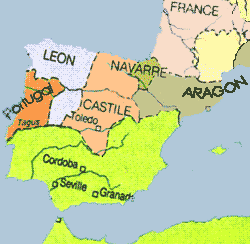
Gathering Wolves – Iberian Peninsular – 12th century
The 5 Christian kingdoms of the north vied with each other to carve up the wealthy but weakened al Andalus.
Navarre, an early contender, lost out to its own colony, Castile. Aragon – already in possession of Provence – took Saragossa in 1118 (more than doubling the population of the kingdom) and pushed along the east coast towards Valencia. Castile (merged with Leon) aimed at Cordoba, Portugal at the Algarve.
The front line moved back and forth. When the Almohads arrived in 1145 they re-adopted the title of caliph and under Yusuf I and his son Ya’qub temporarily drove the Christians back into the mountains. They went down to defeat by the Castilians at Alarcos in 1195.
‘Reconquista’ – Barbarians from the North Claim a Dubious Heritage
In 1130, a French cleric Aimery of Poitiers, a monk with close ties to Santiago, produced a ‘Pilgrim’s Guide.’ It became one part of a compilation of documents called ‘Codex Calixtinus’ (after Pope Calixtus II, 1119-1124) – a mission statement for the conquest of Spain. Charlemagne himself was written into the story of St James.
Energetically promoted by the metropolitan Archbishop Diego Gelmírez (1100-1140) – storytellers were hired to travel about the European countryside spreading ‘news’ of the miracles of St. James and his relics – Santiago was soon ranked with Rome and Jerusalem as one of the great destinations of medieval pilgrimage. Pope Calistus II himself declared that pilgrims who went to Santiago in a Holy Year would be ‘free of all their sins’.
The Codex Calixtinus closely associated the noble task of pilgrimage with the no less noble task of vanquishing the Moors. In the ‘miracles of St James’ the Christian god was providing an assurance of legitimacy for the cause. A war of plunder and conquest could now assume the character of a holy crusade. Military orders proliferated, most notably the knights of Santiago, Alcantara and Calatrava. Even the Visigothic and Roman past – scarcely having any lineage to adventurers from the Frankish lands – assumed a sacred if fanciful reverence, used to validate their own political ambitions. Conquest became ‘Reconquest’.
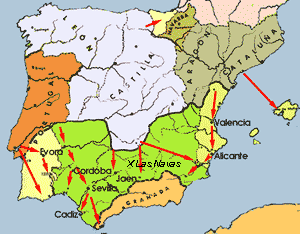
Final Conquest of the South – 13th century
James of Aragon began the major assault on the heartland of al Andalus by conquest of the independent sheikdom of Valencia.
1212 saw the decisive defeat of Islamic forces at the Battle of Las Navas de Tolosa.
Cordoba fell in 1236, Valencia in 1238, Murcia in 1243 and Seville in 1248.
The Caliphate Fragments, Aragon Inflates – 13th century
Whilst the Islamic forces continued to be riven by internecine conflict the Christian princes eventually learned the value of unity.
In 1212, the Battle of Las Navas de Tolosa, proved to be one of the most decisive in the history of the peninsula. Urged on by Pope Innocent III, a rare grand alliance of rival would-be conquerors – Alfonso VIII of Castile, Sancho VIII of Navarre, Pedro II of Aragon, with additional troops from Portugal and Leon – smashed the Muslim forces. Only one-third of Spain was left under Muslim control and even that was once again fragmented into tribute-paying principalities. Granada remained the sole independent Muslim kingdom.
With gathering momentum, the ‘reconquest’ rolled on. In 1229 James I of Aragon began the conquest of the Balearics while Alfonso IX of Leon (1188 – 1230) advanced along the River Guadiana, taking Merida and Badajoz. His successor Fernando III, king of united Castile and Leon, conquered the key cities of Cordova, Murcia, Jaen and Seville.
The main contenders were thus reduced to two: Castile and Aragon. A slowly shrinking Granada held out for another two hundred years.
In 1469 the marriage of Isabel I of Castile and Fernando II of Aragon created Spain. Twenty three years later, after an eight-month siege, the ‘Reconquest’ was completed with the fall of Granada.
In a splendid celebration of the triumph of Christ, three months later all Jews were expelled from the peninsular. The Muslims, initially afforded a degree of autonomy and tolerance, were increasingly penalized. Public calls to prayer were forbidden. The Muslims were subjected to higher taxes and were steadily pushed from the cities into peasant servitude. In 1556, Arab dress itself was banned and then, in 1566, the Arabic language forbidden. Finally, in 1609, Philip III expelled the Muslims from all his domains.
Christ had triumphed in Spain and – after a brief flowering financed by plunder from the Americas – the nation sank into unremitting decline.
Land of the Port – Portugal Gets Its Dose of Christian Fervour
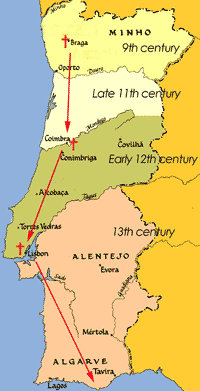
Five centuries of Muslim civilization in Portugal ended in 1272 when Christian knights conquered the Algarve (from Arabic “Al-Gharb” meaning “the country of the west”).
As in Spain, violent, religious warriors from the north eclipsed a more advanced, though moribund, civilization.
Lusitania was a thriving Roman province. In the 5th century the region passed into the rule of Visigothic kings along with the rest of Iberia – but Suevi tribesmen continued to press from the north. They were finally suppressed only shortly before the 8th century Muslim conquest of the whole peninsula.
For centuries Muslim/Arab culture thrived in western Iberia, particularly in the al’Garve and the Alentejo (region ‘beyond the Tagus’). Settlers in the region were primarily Berber tribesmen in the service of the Arabs. Despite all that followed they left their mark in food, agriculture, architecture, language – and race.
The first Christian intrusion was probably in 868 when Vímara Peres, an adventurer in the service of Afonso III of Leon, conquered an area of moorland and forest between the Minho and Douro rivers.
Port of Entry
More seriously, towards the end of the 11th century a motley crew of would be Christian crusaders, en route to plunder Saracen lands in the east (Pope Urban II had proclaimed the holy war in 1095) were blown into the estuary of the Douro. With the opportunity to kill infidel and seize booty close to hand they went no further but instead built a port on the ruins of a Roman city at the mouth of the Douro– Portus Cale. Now the site of Oporto, their colony popularised the region’s medieval name Terra portucalensis or ‘Portugale’.
The would-be ruler of the region, Alfonso VI (1072-1109) of Castile, increasingly dependent on French knights for the conquest of al Andalus, was offering the usual medieval inducements of land and dynastic marriage. Thus it was that Henry of Burgundy took Teresa of Leon as his bride and command of an obscure border fiefdom – the ‘County of Portucalense’.
A Case of Burgundy
In 1112 Henry’s son Alfonso Henriques became the second Count of Portugal with his mother acting as regent. The young Alfonso became a pawn of the Church and of the Portuguese barons who sought independence from Leon-Castile.
In 1120 Hugo, Bishop of Braga, made the 11-year-old the figurehead of opposition to the house of Castile. Teresa exiled them both to Zamora in Leon but at the age of 14 the impressionable Alfonso was placed at the head of an army. A 4 year civil war followed, leading to the defeat of his mother’s Leonese forces at the ‘Battle of Sâo Mamede.’ Teresa herself was confined for the remainder of her life to a monastery in Leon. The following year (1139), after the ‘Battle of Ourique’in the far south, the bishop of Braga crowned Alfonso ‘King of Portugal’ at Lamego.
Crusaders coming ashore on the banks of the Douro a few years later were persuaded to join Henriques’s cause and in a particularly bloody campaign in 1146/1147 Lisbon and its region were saved for Christ.
The Pope Says Yes
Recognition from the papacy was crucial for what, to the kings of Castile, was rebellion. While war with Castile dragged on for years, the local Catholic Church was rewarded with lands, monasteries, privileges and exemptions. Dynastic marriage followed (to Mafalda, daughter of Count Amadeo III of Savoy) and ambassadors were sent to Rome to negotiate. ‘Expulsion of the Moors’ from the Iberian peninsula became a sacred promise.
In 1179 the privileges and favours heaped on the Catholic Church paid their dividend. In a papal bull, Pope Alexander III recognized Afonso as king of an independent Portugal – and one with ‘the right to conquer lands of the Moors’.
True to their promise, in 1272, with the conquest of Faro, the last Muslim community on Portuguese soil was eliminated and another Christian country was established upon bloodshed and destruction.
- Bernard Reilly, The Medieval Spains (Cambridge UP, 1994)
- Sarah Hopper, To Be A Pilgrim (Sutton, 2002)
- Brian & Marcus Tate, The Pilgrim Route to Santiago (Phaidon, 1987)
- Donald Matthew, Chronicles of the Middle Ages (Angus, 1991)
- Colin McEvedy, The Penguin Atlas of Medieval History (Penguin, 1987)
- David Birmingham, A Concise History of Portugal (Cambridge UP, 1993)
- Stanley Lane-Poole, The Moors in Spain (Darf Publishers, 1984)
- James Harpur, Sacred Tracks-2000 Years of Christian Pilgrimage (Frances Lincoln, 2002)
- John Matthews, Bob Stewart, Warriors of Medieval Times (Firebird, 1993)
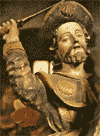
In a brilliant example of an ecclesiastical scam, when the thousands of pilgrims eventually reached Santiago de Compostela they were sold sea shells.
The raison d’être for this ‘badge of pilgrimage’ was that, in a rescue mission, St James had saved a rider washed out to sea. The fallen knight had emerged from the water covered in scallop shells. Yep.

“James sells sea-shells on the sea shore…”
Seeing is Believing?

See that lump of stone? – that’s the mooring post for James’ stone boat. Really.
(Church of Santiago, Padrón)
Rough, Tough, God-fearing

Christian mountain tribesmen – and that’s in the early 20th century (Caucasus)

Collect the Whole Set!
Win a Prize!
To add to the fun pilgrims could collect a badge from each shrine along the route. A complete set assured them of a free meal when they eventually reached Santiago – assuming they didn’t die on the perilous journey!

Monte del Gozo
By adding a stone to a cairn on a hill overlooking Santiago a pilgrim could earn himself a remission of 100 days from his posthumous stint in purgatory.
Guaranteed.
No Irony Intended …

Distinctive Moorish horseshoe-style entrance to the chapel of St James, the Moor-slayer!
(Royal nunnery, Las Huelgas, Burgos, northern Spain.)

Mozarabic style chapel of St Michel-d’Aiguilhe, Le Puy en Valey, France.
Raiders and Traders
The Muslims who settled in the region of Saragossa tended to assert their autonomy from Cordoba, even to the point of allying themselves with the minor Christian states and hiring Christian mercenaries to fight fellow Muslims.

10th century al Andalus
Trade between Islam and Christendom became possible – and the Christians wanted so much of what was produced in the empires of Islam.
In response, the Christian princes of Europe licensed slave traders – usually Jews – who exchanged mainly Slav captives and furs from the Baltic for all the delights of al Andalus.
‘Moorish’ science and technology went north, along with the fine fabrics, leather goods and wine.
Vikings
The Vikings began raiding the coasts of al-Andalus in 844. Major attacks occurred in 966 and 971.
But once the Norsemen lost the element of surprise they found al Andalus a tough opponent.
They switched to trading with the Muslims and moved on to softer targets in France and Italy.
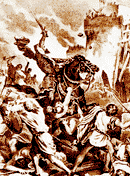
Christian Hero
Turn-coat adventurer, war-lord El Cid Campeador (‘Lord Champion’) captured Valencia in 1094 and resisted repeated attacks by Almoravid troops to retake it.
With his death in 1099 the Christians abandoned the city, setting fire to much of it before they left.
Vicar of Christ
Lord of the World

Pope Innocent III (1198-1216)
“We are the Vicar of Jesus Christ before whom every knee shall bow.”
When he got the top job in 1197 Innocent III moved fast and ruthlessly to assert papal autocracy. He broke the power of the Kingdom of Sicily, brought the German Empire to heel, and successfully chastised King John of England (he condemned Magna Carta).
But it was a subsequent episode which marked a blood-drenched climax to medieval papal malevolence.
Languedoc/ Provence in southeast France was in easy contact with Islamic Spain (the County of Barcelona had formed a union with Provence in 1112). Partly in consequence of that link the Languedoc was the most prosperous region of Christian Europe.
Much to the anguish of the corrupt Catholic clergy Languedoc’s urbane and tolerant princes allowed a non-Catholic Christianity to flourish – Catharism.
Innocent III summoned Europe’s princes and adventurers – drunk on the plunder of Constantinople the year before – to a special Albigensian crusade – against the Christians of southwest France!
In reward for 40 days service a holy warrior would receive ‘forgiveness of all sins and – possibly – lands in the Languedoc.’
The crusade turned into a pitiless rampage of murder and pillage.
The rape of the Languedoc went on for 18 years and reduced the region to a wasteland.
Most infamously at Beziers, a town populated by both Cathars and Catholics, Arnald-Amalric, the papal legate, told his troops:
“Kill them all; the Lord will look after his own.“
In a single town, twenty thousand Christians perished that day – several times the number killed worldwide in the entire reign of Emperor Diocletian – and on the orders of the Pope!
Innocent III, encouraged by success in Languedoc, urged his holy warriors into a new push in Spain. The Battle of Las Navas de Tolosa followed.
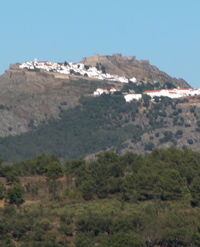
Christian charity
Below the fortified mountaintop village of Marvão, is the small town of Portagem (meaning “toll”).
It was through here that the Christian king of Portugal allowed Jews fleeing Spain to enter his kingdom. His soldiers were on hand to help to collect the Jewish contribution. A small tower marks the “taxation” point.
